When some Jehovah’s Witnesses came to the door recently and asked about my own faith, I told them that I was a “secular buddhist” — which is to say I considered myself a non-theistic person guided by a scientific preference for direct evidence over dogma, and in grey areas of emotional and spiritual life and issues of teleology am informed by a more or less buddhist sensibility that rejects the split between this floating world and some Platonic ideal.
Whew!
So, the perennial question arises: how does a purely secular person who does not embrace the colorful stories of an infinite, personal God and of an eternal, indestructable soul find Hope or Meaning in this one, small finite life amidst a cold impersonal universe ?
Consider this entry (and its title) to be my own offering to you all, in the spirit of the holidays. It’s a bit long winded and technical in parts, but if you can just suspend disbelief for the moment, I promise that by the end you will, at least, have a glimpse into another way of Looking at Things, that if not as bright and shiny as the stained glass of a church, is still a very good story in its own right, and at least makes the adventure of life seem a good and worthwhile thing, while simultaneously taking the hard and painful edge off of the prospect of inevitable Death. Not only that, but unlike most inspiring stories it may actually turn out to be true.
But First, a Little Astronomy
 Here is a picture of the constellation Orion that I took a month ago, while standing outside our house on a cold and freezing midnight, watching the Geminid meteor shower (click to enlarge the photo). I put the camera on a tripod and set it for a 30 second exposure, cranking down the aperture so the stars wouldn’t be such large blobs. There is still a little bit of smearing in the picture due to the rotation of the earth.
Here is a picture of the constellation Orion that I took a month ago, while standing outside our house on a cold and freezing midnight, watching the Geminid meteor shower (click to enlarge the photo). I put the camera on a tripod and set it for a 30 second exposure, cranking down the aperture so the stars wouldn’t be such large blobs. There is still a little bit of smearing in the picture due to the rotation of the earth.
There are many stars and nebulae inside this constellation, but the brightest and most noticeable ones consist of the four stars forming the outer corners of Orion, along with the three in the middle forming the “belt”. The orange star in the upper left corner, for example is the red-giant called Betelgeuese, which is approximately 640 light-years from earth. Diagonally opposite, in the lower right corner, is the blue supergiant Rigel, roughly 770 light years away. The other stars in the constellation range in distance from just 26 light years up to 32,000 light years away.
The Orion (Crab) nebula is difficult to discern in this picture, and I would need to go for a very long exposure (with telescope star-tracking mount) to bring it out clearly. It is one of the three “stars” that form a vertical “sword” beneath the belt. Parenthetically, two days after this picture was taken we watched a movie called “The Fountain” with Hugh Jackman, in which Orion and its Crab Nebula were featured prominently. An interesting movie, which reminded me a bit of “Pan’s Labyrinth” — but I digress.
A Simple Question
Before I go on, I would like to pose a question about your own beliefs: do you believe that those stars and nebulas in the Orion constellation actually exist, in the same way that the upholstered chair you are sitting in exists, and with the same, near-absolute, level of certainty? You don’t have to tell me your answer, just hold on to that thought for a moment.
What We Now Know
You might have noticed that when I listed out the stars in the constellation that I used the traditional unit of “light-year” to indicate how far away those stars were. It seems a bit strange, I’m sure, to have a time-flavored word like “year” involved in a unit of distance, but that is really an essential clue to the modern view of the universe. A light-year is simply the distance that light travels in the vacuum of space in a single year, roughly six trillion miles. It makes really big distances a lot easier to work with. There are twelve light-months in a light-year, for example, and sixty light-minutes in a light-hour. Our own sun is just eight light-minutes from Earth, which sounds a lot less daunting than 93 million miles.
Alas, like a parent with a child nearing puberty, the time has now come for us to sit down and have a mature, frank discussion about Einstein’s theory of Special Relativity. There is simply no way around it. Take a deep breath. The childhood days with all those stories you were told to make things simple have now passed. To get along in the world of adults, where Newton’s and Aristotle’s and Plato’s model of the world are quaint toys to be put away, you must unlearn some things you thought to be “True”, and try to accept what has been learned about the Way the World Works. Nobody wanted it to be this way, not even the scientists, not even Einstein, but the results of hundreds of thousands of experiments rejected all other possibilities, and with great humility the scientists had to let go of the old stories that they once held dear, and begin to think differently.
Here is the old story that they once held dear:
| The world is all the stuff in space that you see around you, and time is something different, a thing that passes as the stuff moves around in space. The world moves through time. |
Here is the new story, as told by Einstein:
| Time is made out of the same stuff as space, and the two seemlingly different things are part of a single whole continuum we call the Cosmos. |
 Like most children who have heard dark rumors about the adult world and what they do behind closed doors, you may have heard things about something called “space-time”. Almost certainly the rumors you have heard have come out mangled, half-truths, with the wrong picture. Most likely, the idea you have gotten is that “space-time” is something where you take the three dimensions of space in which our world exists, and then tack on a time-axis to make it four-dimensional. That is actually the old view, the one that Newton and Lagrange and all the others have always used. Here, for example, is a space-time diagram of the (blue) earth orbiting around the sun over the course of a year.
Like most children who have heard dark rumors about the adult world and what they do behind closed doors, you may have heard things about something called “space-time”. Almost certainly the rumors you have heard have come out mangled, half-truths, with the wrong picture. Most likely, the idea you have gotten is that “space-time” is something where you take the three dimensions of space in which our world exists, and then tack on a time-axis to make it four-dimensional. That is actually the old view, the one that Newton and Lagrange and all the others have always used. Here, for example, is a space-time diagram of the (blue) earth orbiting around the sun over the course of a year.
The new view is that what “space-time” means is there is really only a single substance (what should we call it? Spice?), and if you grab a glob of it near you, you can if you like draw some lines in it and call them “time” and “space”, but those lines are completely arbitrary, and the direction you travel through the “spice” are completely up to you. Space and Time are interchangeable, and the “exchange rate”, expressed as a ratio of space-per-time, just happens to be c, also known as the speed of light.
Thinking Differently
In this new view, there are many words which we have always used, which need to be modified or understood differently. Even the rules of grammar and syntax need to be changed.
For example, as I write this, there is a classical guitar in its case, leaning against the wall of my office, about ten feet from my desk. That is the old way of looking at things. Light travels about a foot in a nanosecond (a billionth of a second), and so the distance between me and my guitar can also be said to be about ten nanoseconds. In both cases I am measuring the same “spice”, using different units. The guitar that I am looking at is actually the one that existed ten nanoseconds ago. There is no difference between separation in space, and separation in time, because they are the same stuff.
As a parenthetical note, there is one old word that anticipated the modern view and which really should be revived: the word “Whence”. It refers to a location, but has the word “when” in it, merging the two ideas of space and time into one.
The thing that sparked the whole Special Relativity thing was the discovery that the speed of light is constant, as it passes through space time. What is not so well known is that this does not just apply to light, but that (according to relativity) every single thing, every single particle of any type in the universe passes through space-time at a fixed, constant speed, which is — surprise! — the speed of light. This speed never changes, ever; the only thing you can control is the direction, which can be more through time or more through space. Even if you are just sitting in your chair, not moving, in space-time you are traveling in an almost 100% “time-like” direction at the speed of light. If you then get in a spaceship and fly off, your motion will now be moving a lot faster through space and, since your speed through space-time is constant, it means you are traveling through time a bit slower. That’s why scientists say that folks who come back from space are a tiny bit younger than they would have been if they had never left. The clocks that they carry with them also appear to verify this.
So, what does all this have to do with life, death, meaning and immortality?
The Past Exists
If you may recall, I had asked you all if you would agree that the stars in the Orion nebula actually exist. The stars that we are talking about are far away, and I had noted that they ranged in distance from 26 light years to over 32 thousand light years away. From the new view of the world, a light year (in distance) is equal to a year (in time), since they both measure the same stuff. So, the star you are looking at that is 26 light years away is the light from that star that left 26 years ago. And the star that is 32 thousand light years away is also 32 thousand years in the past. And yet, you agreed with me that these particular stars exist.
This is true, because the one, difficult to believe, thing that appears to be correct is: The Past Exists.
Let’s be very clear about this: in every sense in which you customarily say something right in front of you exists, the things and events which we think of here and now as being in the Past, actually still exist, as real and as tangible parts of the Cosmos as the classical guitar that rests against the wall of my office, waiting to be played.
This is not an idle speculation, and it has real consequences. Let’s go back to the Orion constellation for a moment. There is a minor star in that constellation called “13 Orionis”, which is 92 light-years away. Let us suppose that you are still having a hard time buying the new idea that the past exists, but that you will grant me the likelihood that the star 13 Orionis has not gone anywhere in the last 92 years and so the same star is still out there, now, as we speak in “the present time”, where you agree that things-that-exist actually live. Suppose that around that star, right now, are orbiting some very powerful telescopes, which can not only see the Earth, but can pick out the people wandering around on it (this is technologically possible with big enough scopes). The light from Earth that they are receiving now left our planet 92 years ago, in 1917.
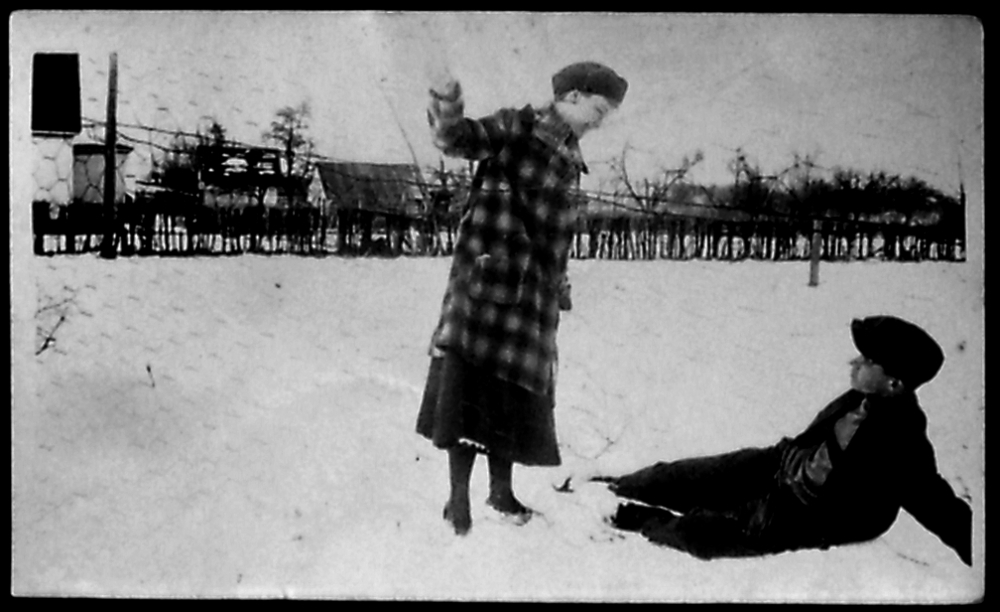 Why did I choose this particular star? 1917 was the year that my grandparents, Lennye and Norvis (Nick), were graduating from highschool in Kentucky, already dating each other and trading letters. Anyone who is now manning the scopes around 13 Orionis and who decides to focus in on western Kentucky will soon be treated to the view of Lennye and Nick, laughing in the snow. Nick has already fallen to the ground and Lennye is about to pummel him with a snowball. They have their whole lives ahead of them, and the America that they know is young, the idea of World War does not exist yet. And they are alive and happy, now, as seen by those watching from the telescopes orbiting the star called 13 Orionis.
Why did I choose this particular star? 1917 was the year that my grandparents, Lennye and Norvis (Nick), were graduating from highschool in Kentucky, already dating each other and trading letters. Anyone who is now manning the scopes around 13 Orionis and who decides to focus in on western Kentucky will soon be treated to the view of Lennye and Nick, laughing in the snow. Nick has already fallen to the ground and Lennye is about to pummel him with a snowball. They have their whole lives ahead of them, and the America that they know is young, the idea of World War does not exist yet. And they are alive and happy, now, as seen by those watching from the telescopes orbiting the star called 13 Orionis.
The Past Exists. Now. In this world we call the Cosmos.
Being Finite
Unless you are four years old, the idea that some of your friends now live a thousand miles away probably does not bother you. Nor should it. Sure, you do not have the ability to be both here and a thousand miles away, but as an adult you are able to sleep well, knowing that your friends are still alive and kicking, in their own homes a thousand miles away. If you push this a bit, it should also not bother you if they were instead a billion miles away, or even six trillion miles — which is to say, a light year — which is to say, a year in time. If a friend passed away a year ago, then, it should not bother you too much. If what we know now is true, your friends are still alive and kicking, in a part of space time that is a measurable distance away: twelve trillion miles, which is to say two light years. So, just as it does not bother you that your own life only spans five or six feet vertically and a foot or so horizontally, it should not bother you that your home in space time is roughly half a quadrillion miles in the long direction. That is the size of your home, and it’s where you live.
So Now What?
So what does this mean? What should a person who comes to accept this idea do with it. What should one do?
Here is my own suggestion, humbly submitted: it means that this life, this span of space-time in which we live our days, is a finite canvas on which we are free to paint whatever kind of experience we choose. The canvas, though finite and bounded in both space and time, is eternally part of the fabric of the Cosmos, and will at any moment once more become visible to someone, somewhere, somewhen, who chooses to look in that particular direction at that particular moment. So what it means is, you have only a small canvas on which to paint, so make it good, and to the best of your ability, make it beautiful.
Or, failing that, at least make it entertaining, and throw a few really good snowballs at someone that you like for good measure.



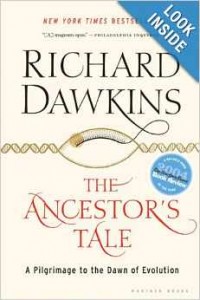
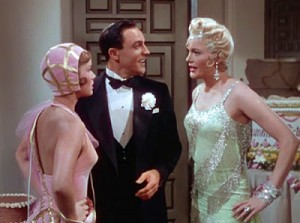

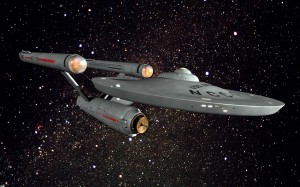

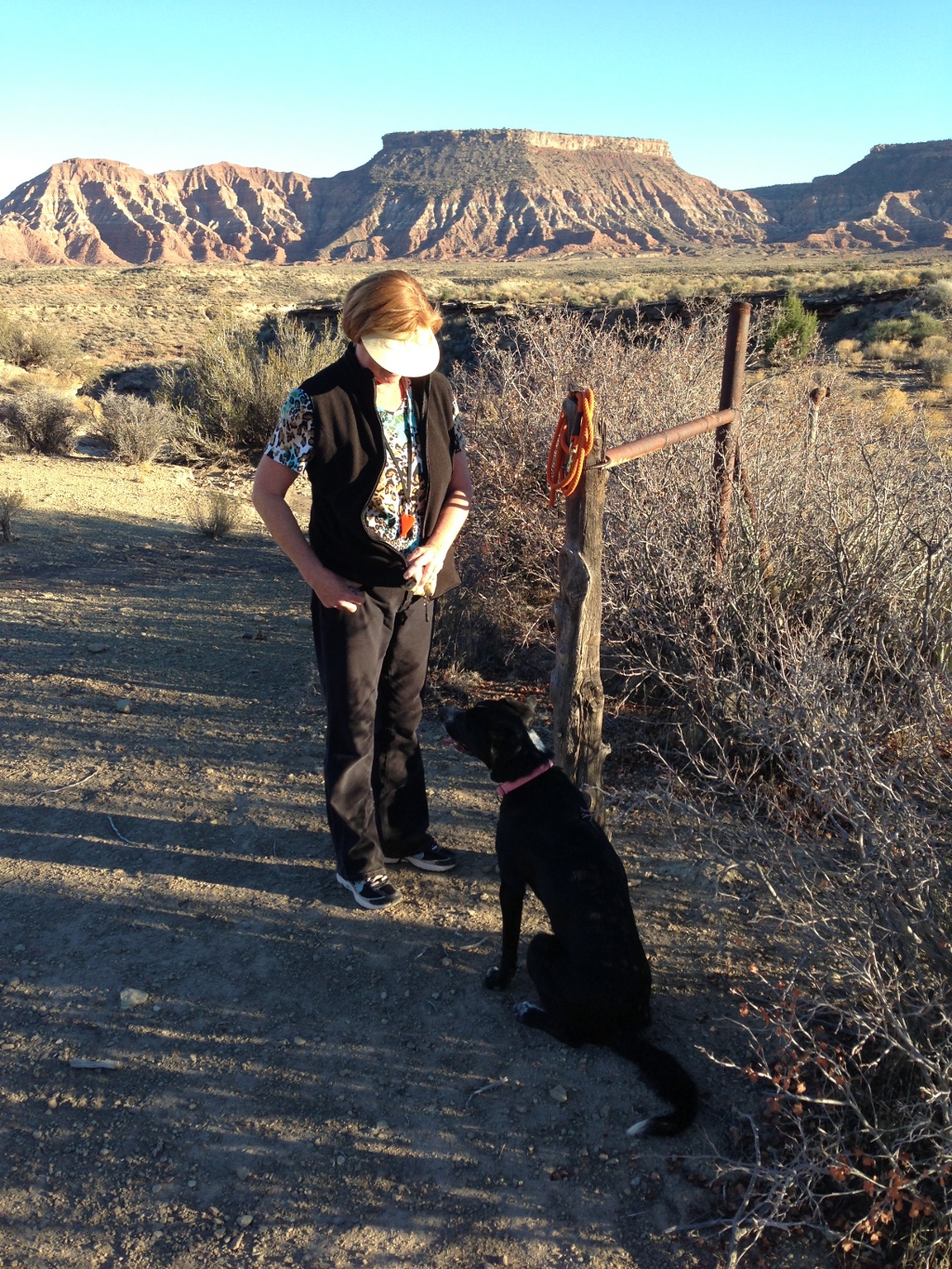 highly energetic border collie mix, a herder breed, who by her nature needs to be walked several times a day, given her shots, kept active and busy or she will eat and destroy your plants, shoes, blankets etc, and needs to be trained not to herd your other pets and kids. You need to be aware of all of this before you give your kids the cute little puppy, so that later you don’t renege on your promise and one day in frustration drive the dog out to a lonely stretch of highway in the southwest Utah desert, and abandon it on the road to be killed by cars or coyotes. If you do such a thing you also abandon your right to be called a Human(e) being. Only if the animal is very lucky, will she find a home occupied by people who take responsibility for the creatures entrusted to them, because they know there is no such word as Have.
highly energetic border collie mix, a herder breed, who by her nature needs to be walked several times a day, given her shots, kept active and busy or she will eat and destroy your plants, shoes, blankets etc, and needs to be trained not to herd your other pets and kids. You need to be aware of all of this before you give your kids the cute little puppy, so that later you don’t renege on your promise and one day in frustration drive the dog out to a lonely stretch of highway in the southwest Utah desert, and abandon it on the road to be killed by cars or coyotes. If you do such a thing you also abandon your right to be called a Human(e) being. Only if the animal is very lucky, will she find a home occupied by people who take responsibility for the creatures entrusted to them, because they know there is no such word as Have.

